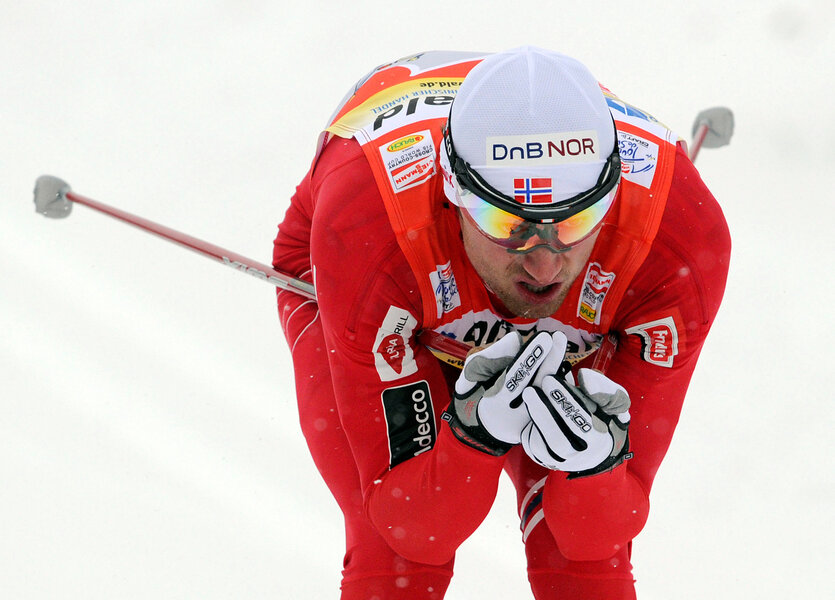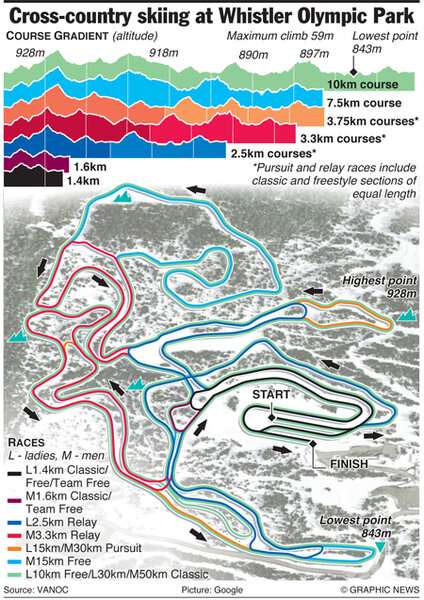Vancouver 2010 Olympic Games: Cross-country
Loading...
The Usain Bolt of cross-country skiing is ready to redeem Norway's 2006 embarrassing relay performance, while a resurgent US team could win its first medal since 1976 at the Vancouver Olympics. Host Canada is also fielding one of its strongest teams, and is likely to help contribute to the country's bid to win the overall medal count as part of its Own the Podium program.
Who to Watch
Petter Northug Jr., NOR (see video)
The Usain Bolt of cross-country skiing, Northug looks like a Ferrari racing Honda Civics when he unleashes his finishing kick that won him three golds at Worlds last year. (See video here of him creaming Germany's top-ranked Axel Teichmann in the final stretch of the relay.) No. 1 in the world leading up to the Olympic events in Whistler, Northug is Norway's most powerful weapon in the winter sport it loves best. But he is not necessarily the most loved member of the team.
In a country that follows Nordic skiing the way America follows football, Northug's decisions and demeanor have been scrutinized relentlessly. Controversial for his Red Bull sponsorship – the energy drink had until recently been banned in Norway – and combative style, he has been the butt of cartoons and more than a little bad press. But the ruffian skier seems unfazed, and says he's ready for the Olympics. On his blog, he cheerfully dispenses advice to fans, including one 11-year-old who was wondering how much he skied at that age. The answer? Six to eight times a day.
Petra Majdic, SLO (see video)
Tall and intimidating in her blindingly fluorescent suit, Majdic has established herself as one of the most dominant skiers on the international circuit – particularly in sprints. The only member of her family to take up sports, she is also the first Slovenian to ever win a cross-country World Cup race or World Championship medal – no doubt part of why Slovenians named her sportswoman of the year three of the past four years. At the Olympics, Majdic could win the country's first-ever gold in a Winter Olympic sport.
Majdic speaks Slovenian, English, and a little German. She's a fan of the book "The Little Prince" and movies including "Boys Don't Cry" and "Million-dollar Baby." You can browse through photos of her from toddler days to World Cup stardom on her website.
A fiery Alaskan who dubbed herself Kikkanimal, Randall won the first US medal in women’s cross-country skiing at the 2009 Worlds. Look for her to add another first with an Olympic medal in the sprint Feb. 17.
Americans to watch: The 2010 Olympics are an exciting year for the US team, which has at least three potential contenders for the country's first medal since 1976. Andrew Newell, a maverick skier from Vermont, is one of the top-ranked sprinters in the world while New Hampshire native Kris Freeman could finally stand on the international podium after missing it by just a hair in distance races, especially the 15 km.
Event details
Click here for schedule and results.
Races are contested in one of two styles: classic, the traditional technique using two parallel tracks, and freestyle, in which a skating motion is used. The exception is the pursuit, which incorporates both techniques and requires a triathlon-like switch of equipment mid-race.
Here are the formats and distances (men/women) being contested at the Olympics:
- Individual start: Skiers start one every 30 seconds and race against the clock. 15km/10km freestyle.
- Mass start: Skiers start together and race head-to-head. 50km/30km classic.
- Pursuit: Skiers start together and contest a classic course (15km/7.5km), then come into an exchange zone and switch to skating equipment (shorter skis, longer poles) and then immediately head out on a freestyle course of the same distance.
- Individual sprint: Skiers race a qualification round on the 1.5 km course. The top 30 qualifiers advance to quarterfinal heats of six. Twelve skiers advance to the semifinals and six to the finals. While qualification times are used to determine international ranking and lane choice in the heats, the medals are awarded based on the results of the final.
- Team sprint: Two athletes alternately ski three laps each on the sprint course, tagging off to each other in between the six total rounds. The best five teams advance to the final round.
- Relay: The relay begins as a mass start, with the first skier from each of the four-man teams lining up shoulder to shoulder. The first two athletes ski a classic leg (10 km/5 km), competing head-to-head with other teams, followed by two freestyle legs.
History
Cross-country skiing has been an important part of northern cultures for thousands of years – possibly as far back as 4,000 B.C. or even earlier. First used as an aid to hunters, skis then became essential military gear toward the end of the Middle Ages in Sweden. Ski racing as we know it is believed to have started in the mid-1800s, and was one of the original Olympic sports in 1924. Women's events have gradually been added since 1952. In recent years, cross-country skiing has expanded to new formats designed to make the sport more exciting for TV and spectators, incorporating sprints and more head-to-head racing – often on shorter loops that pass through the stadium more frequently.
The kicking and gliding motion of the classical technique is achieved using kick wax, a sticky substance applied to the center section of the ski that adheres to the snow, allowing the skier to spring forward without the ski slipping backward. Air and snow temperature, humidity, and the freshness of the snow – all of which affect the shape of the snow crystals – determine which wax will work best. If the snow is like little round balls, you'll need something really sticky. If the snow crystals are like little daggers, you need something really hard for the daggers to bite into. In addition, glide wax is applied to both the tips and tails of classic skis, and the full length of skating skis.
Waxing is an art, and teams spend hundreds of thousands of dollars to make sure they have the best wax for the snow conditions. It can be especially tricky in a place like Whistler, where there are often quick and dramatic changes in conditions, and the temperature is often near freezing – the trickiest range for waxing.
Sources: International Ski Federation, teamnorthug.no, http://petra-majdic.nainternetu.com, fasterskier.com






